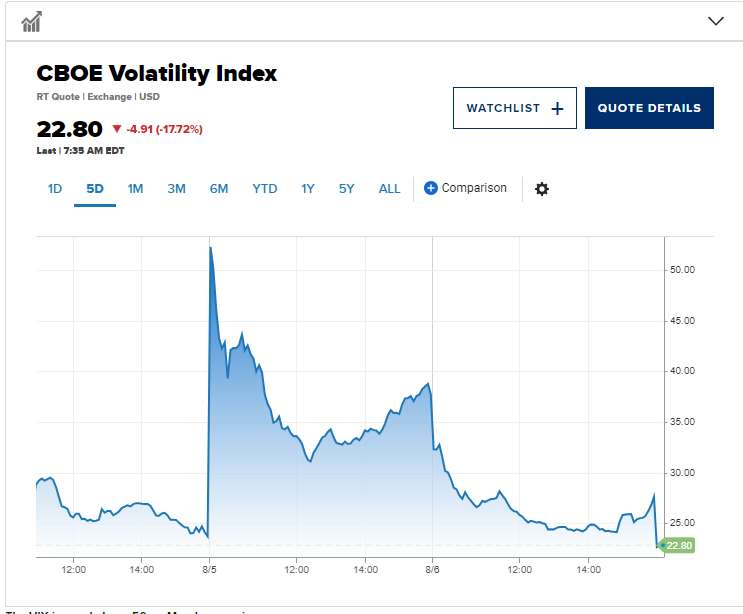Wall Street's fear gauge, VIX, hits highest level since 2020 pandemic market crash
Published by: 09.08.2024 15:27:24Highlights:
- Monday morning's peak was the highest level the VIX has reached since March 2020, shortly after the Federal Reserve took emergency measures during the Covid-19 pandemic, according to FactSet.
- In March 2020, the VIX reached as high as 85.47, according to FactSet.
- The VIX is calculated based on market prices for options on the S&P 500.
A key indicator of expected stock market volatility rose to its highest level in more than four years on Monday morning as global stocks fell sharply. The Cboe Volatility Index, or VIX, briefly topped 65 on Monday morning, up from around 23 on Friday and around 17 a week ago. By about 4 p.m. ET in New York, it had eased to around 38.6, which would still be its highest closing level since 2020. Monday morning's peak was the highest level the VIX has reached since March 2020, according to FactSet.

In March 2020, the VIX rose as high as 85.47, according to FactSet. The VIX is calculated based on market prices for options on the S&P 500. It is designed as a measure of expected volatility over the next 30 days and is often referred to as Wall Street's "fear gauge." Jim Carroll, senior wealth advisor at Ballast Rock Private Wealth, said the size of the initial move on Monday may reflect traders adding protection – or moving from short-dated options to longer-dated options – during a period when the market struggled to meet that demand. “It's clear now that we're at VIX 34-35 instead of 65 that we've seen a squeeze outside of regular trading hours. People were interested in those put options. They chased them. They couldn't get them. They were still chasing them,” Carroll said Monday morning.
Put options are a type of derivative that traders use to add downside protection to their portfolios. Since the sell-off during Covid calmed down, the VIX has been subdued, often trading below its long-term average of 20. Some market experts speculate that the proliferation of other types of derivatives, including increased trading in zero-day-to-expiry contracts, could be contributing .
However, in the current week, the VIX has seen a decline and stocks are starting to climb back towards their previous values. While VIX swings often correspond with deep market declines, they can also be short-lived and precede a stock rally. “You have to watch the VIX. When the VIX peaks and starts to come down, the recovery can be just as quick," Tom Lee, head of research at Fundstrat, said Monday on CNBC's "Squawk Box."
However, Carroll noted that the index cooled off during Friday's session as well, only to rise again over the weekend, and said Monday's moves should not be taken as a "signal to declare the end of the troubles." "If you just removed the long tail at the top of the VIX candle and said , 'Look, we're at 35.'
Documents to download
K&L Rock also declares that it is not liable for any direct or indirect damage resulting from trading on the capital markets in general, and posts in discussions expressing the views of readers may not be in line with the operator's position and therefore cannot be regarded as its views.



